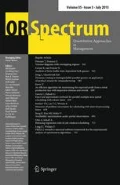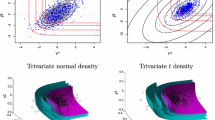Abstract
This paper discusses risk measurement and portfolio selection under the mean-risk framework. Through introducing a nonlinear convex transformation to large losses, we propose a new class of risk measures which are convex and monotone. We demonstrate the new risk measure’s favorable financial and mathematical properties, and consider its estimation in practice and relevant consistent and asymptotic issues. A realistic portfolio selection model based on the new risk measure is then established with typical market frictions taken into account simultaneously. Based on trade data from Chinese stock markets and American stock markets over stable and volatile periods, respectively, both in-sample and out-of-sample empirical studies are carried out. Theoretical and empirical results show that the new risk measure and the corresponding portfolio selection model can not only reflect different investors’ risk averse attitudes and control the fat-tail phenomenon of the return distribution, but also find a realistic optimal portfolio with superior performance and robustness than the corresponding optimal portfolio obtained under the expected shortfall risk measure.
Similar content being viewed by others
References
Abbas Ali E, Hann I-H (2010) Measuring risk aversion in a name-your-own-price channel. Decis Anal 7(1): 123–136
Acerbi C (2002) Spectral measures of risk: a coherent representation of subjective risk aversion. J Banking Finance 26: 1505–1518
Acerbi C, Tasche D (2002) On the coherence of expected shortfall. J Banking Finance 26: 1487–1503
Artzner P, Delbaen F, Eber JM, Heath D (1999) Coherent measures of risk. Math Finance 9: 203–228
Bertsimas D, Lauprete GJ, Samarov A (2004) Shortfall as a risk measure: properties, optimization and app1ications. J Econ Dyn Control 28: 1353–1381
Biglova A, Ortobelli S, Rachev S, Stoyanov S (2004) Different approaches to risk estimation in portfolio theory. J Portfolio Manag 31: 103–112
Cheng S, Liu Y, Wang S (2004) Progress in risk measurement. AMO Adv Model Optim 6(1): 1–20
Chen Z, Wang Y (2007) A new class of coherent risk measures based on p-norms and their applications. Appl Stoch Models Bus Ind 23(1): 49–62
Chen Z, Wang Y (2008) Two-sided coherent risk measures and their application in realistic portfolio optimization. J Banking Finance 32(12): 2667–2673
Chen Z, Yang L (2011) Nonlinearly weighted convex risk measure and its application. J Banking Finance 35(7): 1777–1793
Clarke R, Davies SW (1983) Aggregate concentration, market concentration and diversification. Econ J 93: 182–192
Delbaen F (2002) Coherent risk measures on general probability spaces. Essays in Honour of Dieter Sondermann, Springer, Berlin, pp 1–37
Dhaene J, Goovaerts MJ, Kaas R (2003) Economic capital allocation derived from risk measures. N Am Actuar J 7(2): 44–59
Farinelli S, Rossello D, Tibiletti L (2006) Computational asset allocation using one-sided and two-sided variability measures. Lect Notes Comput Sci 3994: 324–331
Fischer T (2003) Risk capital allocation by coherent risk measures based on one-sided moments. Insur Math Econ 32(1): 135–146
Föllmer H, Schied A (2002) Convex measures of risk and trading constraints. Finance Stoch 6: 429–447
Krokhmal P, Palmquist J, Uryasev S (2002) Portfolio optimization with conditional value-at-risk objective and constraints. J Risk 4: 11–27
Lucas A, Klaassen P (1998) Extreme returns, downside risk, and optimal asset allocation. J Portfolio Manag 25: 71–79
Morgan JP (1996) RiskMetrics. Technical Document. 4th edn. Morgan, Newyork
Pennings J, Smidts A (2003) The shape of utility functions and organizational behavior. Manag Sci 49(90): 1251–1263
Perold AF (1984) Large-scale portfolio optimization. Manag Sci 30(10): 1143–1160
Pflug G, Wozabal N (2010) Asymptotic distribution of law-invariant risk functionals. Finance Stoch 14(3): 397–418
Rockafellar RT, Uryasev S (2002) Conditional value-at-risk for general loss distributions. J Banking Finance 26: 1443–1471
Rockafellar RT, Uryasev S, Zabarankin M (2006) Generalized deviations in risk analysis. Finance Stoch 10: 51–74
Silver MS (1985) On the measurement of changes in aggregate concentration, market concentration and diversification. J Ind Econ 33: 349–352
Smidts A (1997) The relationship between risk attitude and strength of preference: a test of intrinsic risk attitude. Manag Sci 43: 357–370
Van Zwet WR (1980) A strong law for linear functions of order statistics. Ann Probab 8: 986–990
Author information
Authors and Affiliations
Corresponding author
Additional information
This research was supported by the National Natural Science Foundation of China (Grant Number 70971109) and the Key Project of the National Natural Science Foundation of China (Grant Number 70531030).
Rights and permissions
About this article
Cite this article
Chen, Z., Yang, L., Xu, D. et al. Tail nonlinearly transformed risk measure and its application. OR Spectrum 34, 817–860 (2012). https://doi.org/10.1007/s00291-011-0271-2
Published:
Issue Date:
DOI: https://doi.org/10.1007/s00291-011-0271-2




